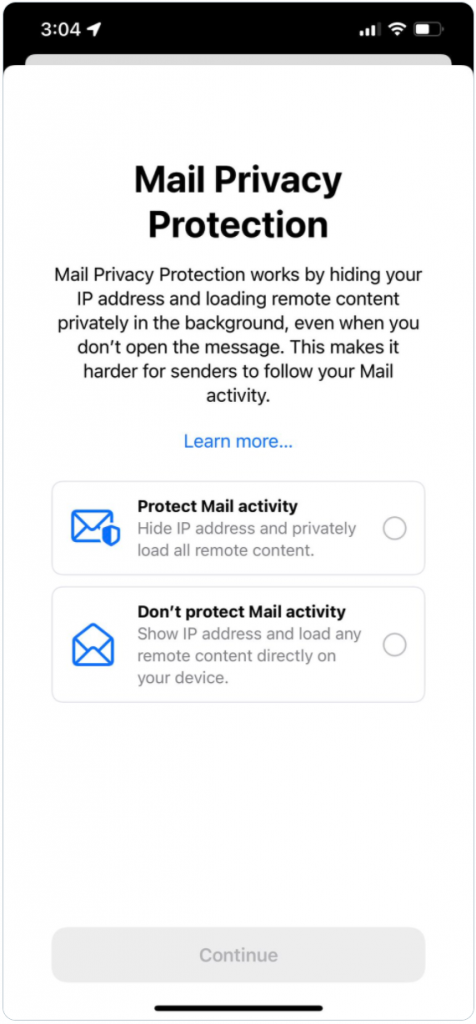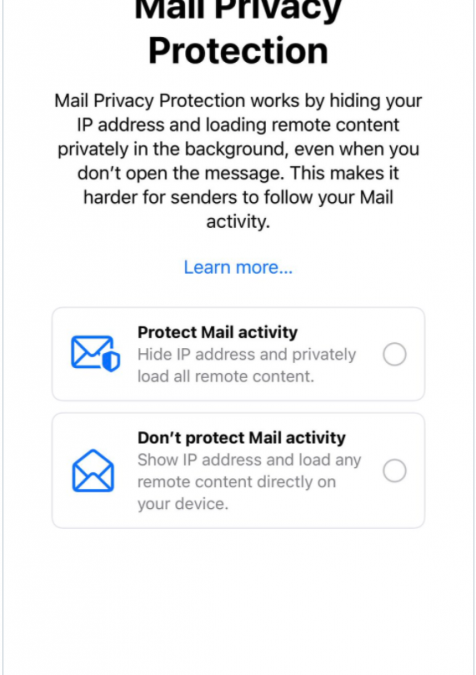Apple just kicked off their annual Worldwide Developers Conference (WWDC 2021) yesterday, and the email community has been abuzz ever since. Why? Three words: Mail Privacy Protection.
Apple announced Mail Privacy Protection for their Mail app on iOS 15, iPadOS 15, and macOS Monterey devices. It’s set to launch this year sometime between September and November. According to Apple, “Mail Privacy Protection stops senders from using invisible pixels to collect information about the user. [It prevents] senders from knowing when they open an email, and masks their IP address so it can’t be linked to other online activity or used to determine their location.”
How will it work?
When someone first opens up the Apple Mail app, they’ll get a message prompting them to either “Protect Mail activity” or “Don’t protect Mail activity.”
 Source: Ryan Jones
Source: Ryan Jones
We’re not quite sure yet how Apple will “stop senders from using invisible pixels” if the “Don’t protect Mail activity” option is selected.
Our guess is that Apple will first route emails through a relay or proxy on Apple’s servers to load tracking pixels before serving that email to readers. Will Apple load all remote images, not just tracking pixels? How will they even differentiate what’s a tracking pixel and what’s just a remote image?
What we do know is this affects any email opened from the Apple Mail app—no matter which email service is used such as Gmail or a work account. However, this shouldn’t affect other email apps used on Apple devices like the Gmail app on an iPhone.
Because of this, you may not be able to tell who opened your emails and when via Apple Mail.
What this might mean for email marketers
Privacy has become a big issue in recent years, not just in the email industry.
This brings to mind the European Union’s General Data Protection Regulation (GDPR) which gives people the right to remove their personal data, therefore anonymizing it to marketers. Then came the California Consumer Privacy Act (CCPA) with its own privacy protections. And most recently, there’s been talk about the loss of third-party cookies.
Maybe it was just a matter of time.
Is the open rate dead?
Because we don’t yet know exactly how Apple will treat tracking pixels, we can’t say for sure how much of an impact Mail Privacy Protection will have on open rates.
Our annual email client market share data shows Apple iPhone, Apple Mail, and Apple iPad with over 46% of combined email opens in 2020. If your audience makeup is also skewed toward Apple Mail users, your open rate may be over-inflated come this Fall (or Spring for those of you down under).
Many marketers have already considered the open rate a vanity metric, but we disagree. However, we believe you shouldn’t rely on opens as your sole performance metric.
So, while it might not be time to put the open rate to rest yet, it’s a great reminder to include—and perhaps emphasize—other metrics instead such as clicks and conversions in your reporting.
What about campaigns and content powered by opens?
Beyond a simple metric, the almighty open is also commonly used for:
- Re-engagement campaigns
- Automated nurture flows
- Send time optimization
- Real-time personalization
- Monitoring deliverability
So even if you decide to no longer use open rate as a measure of email marketing success, Mail Privacy Protection could still hurt your email program in other ways.
Brian Sisolak put together a great thread on Twitter:
It’s been about 12 hours since @Apple announced Mail Privacy Protection and this looks like this might be a watershed moment for #emailmarketing. Besides just opens, there are several additional consequences … see thread… and add your own!
— Brian Sisolak (@bsisolak) June 8, 2021
Again, this is all speculation right now. Assuming the worst, some of the potential effects for your Apple Mail audience who opts in to Mail Privacy Protection could be that:
- Any audience cohort, segmentation, or targeting based on last open date would be rendered useless—especially critical for purging unengaged contacts.
- Automated flows and journeys that rely on someone opening an email would need to get re-engineered.
- A/B testing subject lines (or anything else) using opens to determine the winner or to automatically send out the winner won’t work anymore.
- Send time optimization would become inaccurate.
- Countdown timers might show outdated times as the cached version was pulled at sent time, not opened time.
- Other content powered by opens such as local weather or nearest store location also wouldn’t be accurate.
- Some interactive emails that reference external CSS might not work.
And regarding list hygiene, George Schlossnagle says:
All of these posts responding to ios 15 blocking open pixels with ‘open rates are a vanity metric’ look past per-recipient opens as a very useful leading indicator of (dis)engagement and important to modern list hygiene. I worry this change will drive regressive behavior.
— George Schlossnagle (@g_schlossnagle) June 8, 2021
Meaning, this may not be great for subscribers either. While Apple’s intention is to protect subscribers, it may backfire with people ultimately getting even more unwanted emails, as Chad White puts it:
Blocking email opens deprives senders of a key list health and subscriber engagement metric. It will lead to more unwanted email for subscribers and more deliverability problems for senders, because it makes inactivity management and engagement-based segmentation impossible. https://t.co/TgBEtBq2rk
— Chad S. White (@chadswhite) June 7, 2021
Here are some stats supporting personalization that people actually want:
- 83% of consumers are willing to share their data to create a more personalized experience. (Accenture)
- 76% of buyers expect more personalized attention from marketers to develop an intimate relationship with your brand. (Demand Gen Report 2020 Buyer Behavior Study)
- 80% of customers are more likely to make a purchase from a brand that provides personalized experiences. (Epsilon)
- 6 in 10 marketers report that boosting personalization in email is a priority. (Litmus 2020 State of Email, Fall Edition)
What about Litmus Email Analytics?
For a few years now, we knew privacy was becoming more and more important in the market. That’s why we took the steps to anonymize our Litmus Email Analytics offering by blocking personally identifiable information (PII), removing IP addresses, and making geo-tracking optional for our customers.
We’ll continue to provide fully anonymized and aggregated insights.
The Litmus Engineering Team is currently analyzing the iOS 15 beta and—just like we’ve also done with the Gmail cache, Yahoo! Mail cache, and Previews clients—we’ll evaluate the situation and act accordingly.
What about other email marketing tools?
There are still so many other questions we don’t know the answer to, including: How will email service providers respond to this and continue to help marketers like you determine email program success? What will real-time personalization tools like Movable Ink and Liveclicker do to make sure they’re still supporting your efforts to deliver the right content to the right people? How will this impact artificial intelligence platforms for subject lines like Persado and Phrasee?
It’s worth repeating: A lot of this is still speculation at this point. So while the future of email marketing remains unclear, there are some things you can do now to prepare.
What you need to do before the iOS 15, iPadOS 15, and macOS Monterey release
Mandi Moshay created a great list of things you should be doing now to get ready, and we couldn’t agree more:
#EmailGeeks: 4 things you should be doing now to get ready for iOS 15:
1) Start testing creative. Understand what is most compelling to your audience to maximize engagement using metrics that can be segmented upon in the future. Recent openers will no longer be an option. 1/4
— Mandi Moshay (@MandiMoshay) June 7, 2021
To summarize (and throw in a few of our own suggestions):
- Size up the potential impact to your program by determining how much of your audience even uses Apple Mail to read your emails. It might not even matter!
- Start testing creative to understand what’s most compelling to your audience so you can confidently continue sending emails that drive engagement.
- Start tracking click-through rate over delivered (if you aren’t already) to set a new, additional baseline for campaign success moving forward.
- Clean up your lead quality, list hygiene, and sender reputation since you may not be able to rely on opens anymore as a sign of a deliverability problem.
- Create audience segments and cohorts that rely on open data so you can keep on using them, at least in the near future.
 |
How many of your subscribers use Apple Mail? Over 46% of email opens come from Apple Mail, but your own audience might be more or less. With Litmus Email Analytics, see how much of an impact Apple’s Mail Privacy Protection could have on your email marketing efforts so you can get your program ready (or not). |
Email marketing will continue to evolve
Apple’s Mail Privacy Protection is certainly a blow to marketing and to consumers who desire a personalized experience from the brands they trust. Our hope is that it inspires the email industry to continually innovate so brands can deliver the best experience for their subscribers and customers. Because at the end of the day, it’s all about the people receiving our emails.
What do you think about the Mail Privacy Protection? How will this change your email program?
The post Apple’s Mail Privacy Protection: What This Means for Email Marketers and How to Prepare Now appeared first on Litmus.
![]()

